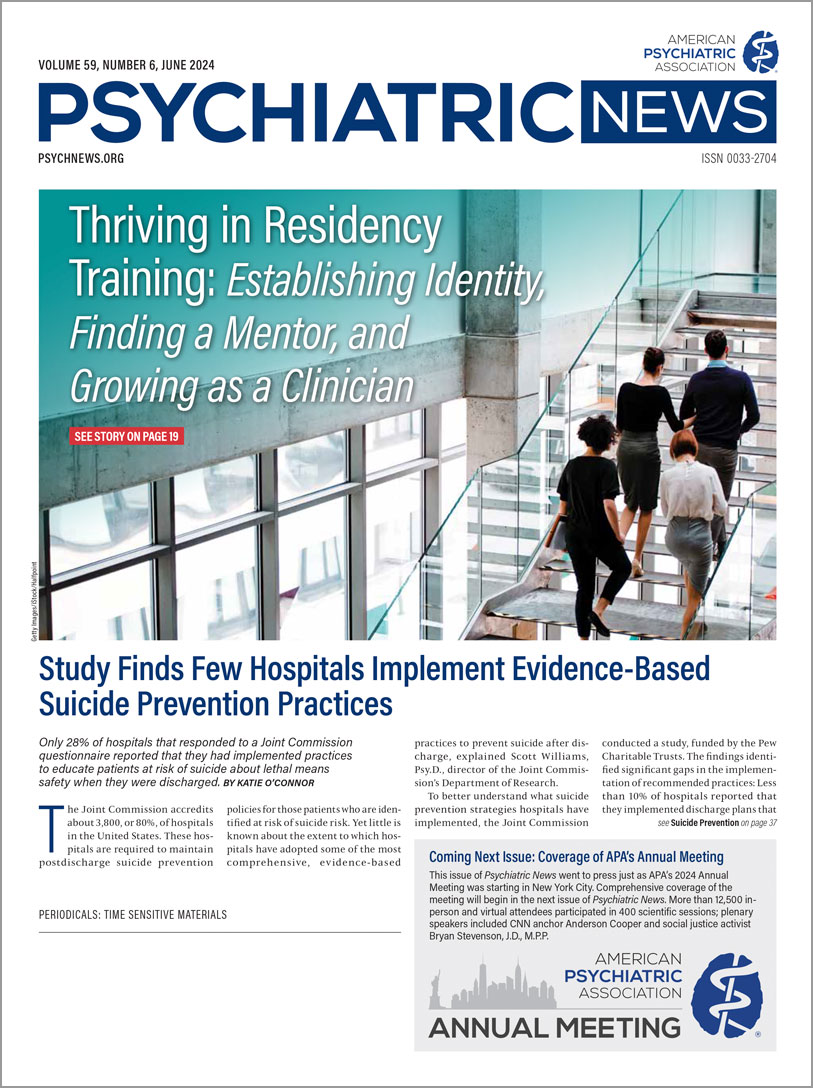Are psychiatrists pain doctors? I struggle with this question. I greatly admire my colleagues in pain medicine and palliative care, as pain is one of the most challenging conditions to treat. It is hard to see a fellow human writhing in pain; it is hard to bear the vocal expressions of pain. Screams make physicians and nurses jump to the higher-grade painkillers, and moans result in shortened visits. It is instinctual—this variant of a fight-or-flight response: Severe pain, when witnessed, results in either immediate action or immediate fleeing the scene.
End-of-20th-century medicine acknowledged the importance of pain by changing the standard of care to include routine pain assessment, together with the established vital signs, as a de facto fifth vital sign. This practice resulted in a significant increase in opioid prescriptions, a significant contributor to the opioid epidemic. In the nature of things, this was followed by a reversed turn of events, including
AMA recommendations against including pain as a fifth vital sign, then a clamping down on opioid prescriptions, culminating with an increase in
pain-related suicides. Pain-related suicides: extreme outcomes that link unbearable physical pain to unbearable psychological pain. Life-promoting fight, as long as there is hope; death-accepting flight when hope vanishes.
Psychological or mental pain, or psychache, with its implicit threat of nothingness, an existential threat, exacerbates our instinct to recoil when we sense it. As a result, psychological pain tends to be
overlooked and underassessed. Opportunities to mitigate the
increased suicidality associated with mental pain are missed, and people die.
What can we learn from comparing physical and psychological pain? Both result in severe distress. Both types of pain elicit similar coping responses: enduring or emotional discharge. Chronic physical pain and psychological pain also share a pertinent negative: a lack of organicity. There are also important differences between acute physical pain and mental pain. Painful inputs stimulating peripheral nociceptors are perceived as an aching sensation, the essential component of acute pain. It is this clear causality characterizing acute physical pain, including objective physical evidence (trauma, fractures, etc.), that makes acute pain one of the least stigmatizing and most empathized with medical conditions. On the contrary, chronic pain and psychological pain, with their common lack of clear causation, are among the most stigmatizing and the least empathized with medical conditions.
Those afflicted by acute physical pain openly share their suffering or ask for help, while those affected by mental pain experience guilt and shame and hide their suffering. Hopelessness is common, as psychological pain is often seen as a choice by both the afflicted and their entourage (which could include their physician). Like many other forms of mental distress, psychological pain is often viewed as partially self-inflicted, with the individual, a generative agent, an active co-creator of his or her pain. To summarize, physical pain tends to stir self-sympathy and external validation of the sick role; mental pain tends to elicit self-stigmatization and external invalidation.
It is essential to consider this cycle of clinical correlates and risk. Shame, hopelessness, and guilt—a fatal triad—independently increase the risk of suicide. Adding insult to injury, this fatal triad also increases the risk of stigmatization, which in turn independently increases suicidality. There is a cumulative body of evidence indicating that
the severity of psychological pain correlates with suicidal risk, and decreasing the intensity of psychological pain decreases the risk of suicide.
The rates of suicide have been on the rise across genders and age groups. Yet, mental pain, a predictor of suicide, remains underappreciated and underassessed. Standard instruments to assess mental pain are available: the
Psychache scale is a self-reported 13-item global mental pain assessment scale with good reliability and validity; specifically aimed to evaluate the suicidal-risk correlates of mental pain, the
Unbearable Psychache Scale (UP3) is a three-item self-rated scale, which can be rapidly completed, has been shown to have good convergent validity with the lengthier Psychache scale and strongly correlates with several suicidal-related risk factors, including suicidal desire, hopelessness, perceived burdensomeness, and thwarted belonging.
Integrating mental pain assessment into psychiatric care could take several forms. Brief screening tools like the
UP3 could be administered at intake and follow-up visits. Clinicians could be trained to probe for psychological pain and incorporate this information into case formulation and treatment planning.
Of course, there are potential barriers to the widespread adoption of mental pain assessment, including time constraints, lack of awareness among providers, and limited training opportunities. Overcoming these obstacles requires education initiatives to raise the profile of mental pain as a critical clinical construct and the need for advocacy to ensure adequate resource allocation for assessment and intervention.
Effectively addressing psychological pain necessitates a multimodal approach. Short-term stabilization of acute distress can be achieved via pharmacotherapy. Long term, the exploration and processing of painful emotions can be completed in psychotherapy.
Peer support, community-based programs, and social interventions are interventions with proven efficacy in decreasing shame and stigma associated with mental distress.
Psychological pain is an underappreciated but critical aspect of psychiatric assessment and suicide prevention efforts. By routinely evaluating it and providing therapeutic resources to mitigate it, we may be able to stem the rising tide of suicide.
It is time to make the evaluation of mental pain a routine part of the mental status examination. As vital signs are predictors of vitality or life, can we consider psychological pain as a cross-diagnostic vital sign?
Not a fifth vital sign but a mental vital sign. ■

